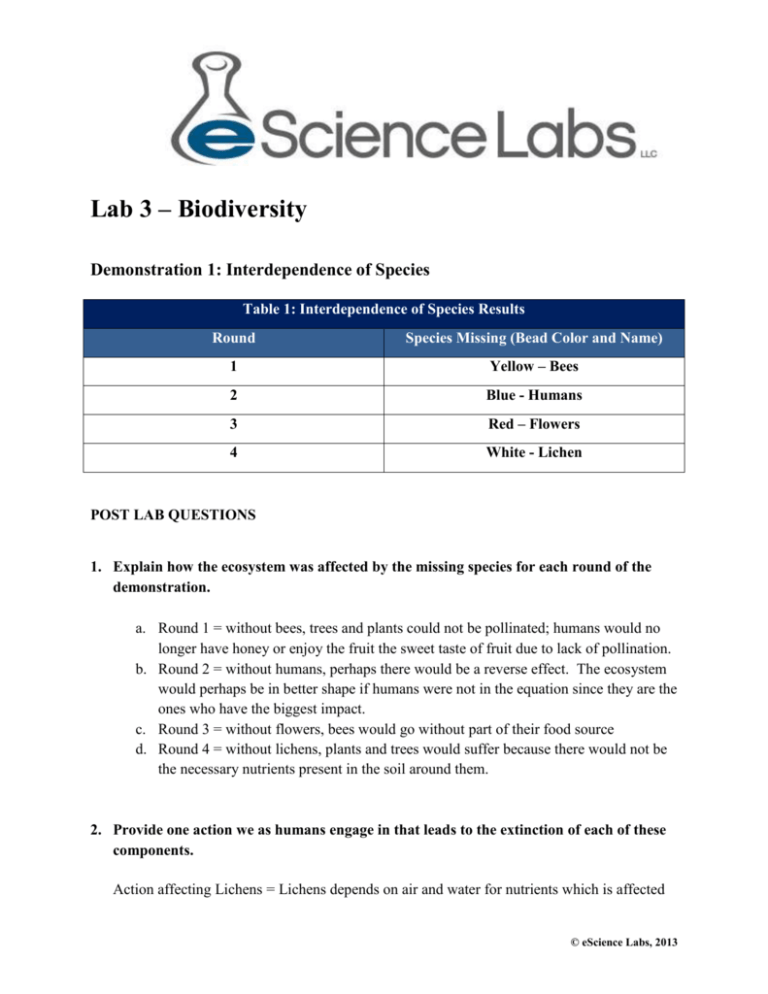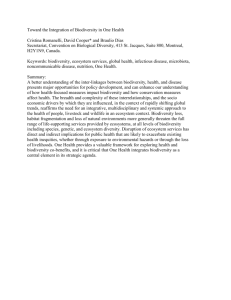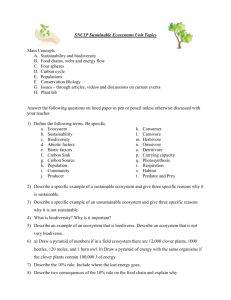sci207.w3.labreportingform
advertisement

Lab 3 – Biodiversity Demonstration 1: Interdependence of Species Table 1: Interdependence of Species Results Round Species Missing (Bead Color and Name) 1 Yellow – Bees 2 Blue - Humans 3 Red – Flowers 4 White - Lichen POST LAB QUESTIONS 1. Explain how the ecosystem was affected by the missing species for each round of the demonstration. a. Round 1 = without bees, trees and plants could not be pollinated; humans would no longer have honey or enjoy the fruit the sweet taste of fruit due to lack of pollination. b. Round 2 = without humans, perhaps there would be a reverse effect. The ecosystem would perhaps be in better shape if humans were not in the equation since they are the ones who have the biggest impact. c. Round 3 = without flowers, bees would go without part of their food source d. Round 4 = without lichens, plants and trees would suffer because there would not be the necessary nutrients present in the soil around them. 2. Provide one action we as humans engage in that leads to the extinction of each of these components. Action affecting Lichens = Lichens depends on air and water for nutrients which is affected © eScience Labs, 2013 by things such as air travel and exhaust fumes. Action affecting Trees = People cutting down trees is one main way that leads to extinction. Action affecting Flowers = People are clearing off land in order to plant crops and trees Action affecting Bees = There is intensive farming being done and as a result eliminate food that bees pollinate from. 3. Provide three specific actions that humans can take to minimize our impact on the ecosystem and ensure the survival of lichens, trees, flowers, and bees. Action 1 = People can do less that contribute to the pollution of air, water and soil and by protecting from pollutants and contaminates. Action 2 = Avoid using pesticides if at all possible. Action 3 = Plant trees and shrubbery in order to help replace those being cut down. © eScience Labs, 2013 Experiment 1: Diversity of Plants Table 2: Number of Each Plant Species Present in Pot 1 and Pot 2 Species Observed Number in Pot 1(sunlight) Number in Pot 2(shade) Zinnia 1 0 Marigold 4 9 Morning Glory 2 0 Cosmos 9 25 Ryegrass 3 30 Total Number of Species in Pot: 4 3 POST LAB QUESTIONS 1. Develop a hypothesis on which pot you believe will contain the highest biodiversity. Hypothesis = The plant in the sunlight will contain the highest biodiversity. 2. Based on the results of your experiment, would you reject or accept the hypothesis that you produced in question 1? Explain how you determined this. Accept/Reject = Reject/I assumed that the pot in the window would grow faster and have a wider range of the different species than the ones in the sunlight. Although the plant in the shade grew more rapidly, it did not produce more species than the pot in the sunlight. 3. If each pot was a sample you found in a group of wildflowers, would you determine © eScience Labs, 2013 based on the diversity of flowers that the ecosystem is healthy? Why or why not. Answer = If the window plant was found in a group of wildflowers, I would assume the ecosystem was healthy because this pot is greener in color and the stems appear healthier. However the shaded plants, although it grew faster; does not look healthy. They are more yellowish and appear to be missing some nutrients. According to the Department of Biology, “Shade-type leaves typically are thinner, have more surface area, and contain more chlorophyll than those of sun leaves,” (Spilatro, 1998). 4. How does biodiversity contribute to the overall health of an ecosystem? Provide specific examples and utilize at least one scholarly resource to back your answer. Answer = Biodiversity is important because without it, living things within the ecosystem, including humans are all part of a web life. Everything has its place here on earth and serves an important role. All species depend and interact with one another so without that diversity, the ecosystem would suffer. According to the California Biodiversity Council, “maintaining a wide diversity of species in each ecosystem is necessary to preserve the web of life that sustains all living things,” (Brown, 2008). References Brown, J. (2008). California Biodiversity Council: What is Biodiversity? Retrieved from: http://biodiversity.ca.gov/Biodiversity/biodiv_definition.html Spilatro, S. R. (1998). Department of Biology, Marietta College, Marietta, Ohio. Photosynthesis Investigation Study Guide: How does photosynthesis differ between ‘sun’ and ‘shade’ plants or leaves? Retrieved from: http://www.marietta.edu/~spilatrs/bio1103/photolab/sun_shad.html © eScience Labs, 2013








